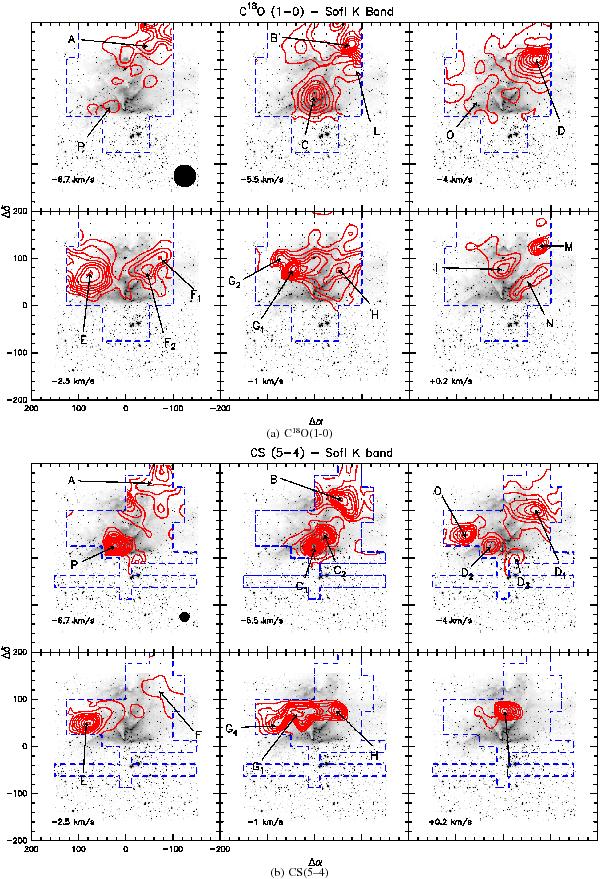Fig. 5

a) Integrated emission  of C18O(1–0) superimposed on the Ks image. Each plot corresponds to a different VLSR. The VLSR of the clumps is indicated in the respective panel. The dashed (blue) lines indicate the observed area. The (red) contours show the integral under Gaussian components fitted to the line profiles. The beam of the transition is shown in the first panel. The first contour in each panel is the 3σ level. The integrated emission levels (in units of K km s-1) are (lowest (step) highest): ( − 6.7 km s-1) 0.17 (0.3) 2.27; (–5.5 km s-1, C) 0.19 (0.3) 1.99; ( − 5.5 km s-1, B) 0.20 (0.5) 4.70; ( − 4.0 km s-1) 0.18 (0.7) 6.48; ( − 2.5 km s-1) 0.19 (0.3) 2.89; ( − 1.0 km s-1) 0.18 (0.2) 1.78; ( + 0.2 km s-1) 0.15 (0.1) 0.65. b) As a), but for CS(5–4). The integrated emission levels (in units of K km s-1) are (lowest (step) highest): ( − 6.7 km s-1) 0.19 (0.3) 2.59; ( − 5.5 km s-1, C) 0.20 (1.0) 10.20; ( − 5.5 km s-1, B) 0.19 (0.5) 3.69; ( − 4.0 km s-1) 0.19 (0.7) 4.39; ( − 2.5 km s-1) 0.18 (1.0) 8.18; ( − 1.0 km s-1) 0.17 (0.2) 1.37; ( + 0.2 km s-1) 0.14 (0.1) 0.74. Note that names of the clumps do not correspond to those used in Massi et al. (1997).
of C18O(1–0) superimposed on the Ks image. Each plot corresponds to a different VLSR. The VLSR of the clumps is indicated in the respective panel. The dashed (blue) lines indicate the observed area. The (red) contours show the integral under Gaussian components fitted to the line profiles. The beam of the transition is shown in the first panel. The first contour in each panel is the 3σ level. The integrated emission levels (in units of K km s-1) are (lowest (step) highest): ( − 6.7 km s-1) 0.17 (0.3) 2.27; (–5.5 km s-1, C) 0.19 (0.3) 1.99; ( − 5.5 km s-1, B) 0.20 (0.5) 4.70; ( − 4.0 km s-1) 0.18 (0.7) 6.48; ( − 2.5 km s-1) 0.19 (0.3) 2.89; ( − 1.0 km s-1) 0.18 (0.2) 1.78; ( + 0.2 km s-1) 0.15 (0.1) 0.65. b) As a), but for CS(5–4). The integrated emission levels (in units of K km s-1) are (lowest (step) highest): ( − 6.7 km s-1) 0.19 (0.3) 2.59; ( − 5.5 km s-1, C) 0.20 (1.0) 10.20; ( − 5.5 km s-1, B) 0.19 (0.5) 3.69; ( − 4.0 km s-1) 0.19 (0.7) 4.39; ( − 2.5 km s-1) 0.18 (1.0) 8.18; ( − 1.0 km s-1) 0.17 (0.2) 1.37; ( + 0.2 km s-1) 0.14 (0.1) 0.74. Note that names of the clumps do not correspond to those used in Massi et al. (1997).
Current usage metrics show cumulative count of Article Views (full-text article views including HTML views, PDF and ePub downloads, according to the available data) and Abstracts Views on Vision4Press platform.
Data correspond to usage on the plateform after 2015. The current usage metrics is available 48-96 hours after online publication and is updated daily on week days.
Initial download of the metrics may take a while.




